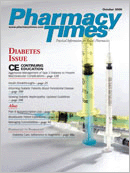GlaxoSmithKline's Avandamet
According to the National DiabetesInformation Clearinghouse, 20.8 millionpeople in the United States have diabetes,which accounts for $132 billion inmedical costs each year.1,2
Approximately 90% of people with diabetesin North America are classified ashaving type 2 diabetes mellitus (DM).1These patients typically are treated withone or more oral hypoglycemic medicationsrather than with insulin. On July 11,2006, GlaxoSmithKline announced theapproval of Avandamet as first-line therapyto control glucose levels in patientsdiagnosed with type 2 DM when dualtherapy is needed.3,4
Pharmacology
Avandamet (rosiglitazone maleate andmetformin HCl) is a combination of 2 oralhypoglycemic agents consisting of a thiazolidineand a biguanide, respectively.The advantage of Avandamet lies withinthe additive effect of 2 different mechanismsof action. Rosiglitazone targetsinsulin resistance and decreases circulatinginsulin levels, whereas metformin reducesglucose production at the hepaticlevel.5 The metabolic processes also differbecause rosiglitazone is primarilymetabolized by the CYP450 isoenzyme2C8 (2C9 minor) and metformin is primarilymetabolized renally.5
Clinical Trials
A 32-week, randomized, double-blindtrial to evaluate the efficacy and safety ofAvandamet, compared with rosiglitazoneand metformin as single agents, confirmedAvandamet's superiority inglycemic control over the 2 monotherapies.4 The inclusion criteria requiredpatients with type 2 diabetes who weredrug-naive. The study defined drug-naiveas not having taken an oral hypoglycemicmedication or insulin for more than 15days within the 12 previous weeks.4
This study evaluated 468 patientsbetween the ages of 18 and 70 years. TheAvandamet treatment arm included astarting total daily dose of 2 mg/500 mg.The investigators were allowed toincrease doses in increments of 2 mg/500 mg, with a maximum daily dose of8 mg/2000 mg.4 Patients in the rosiglitazonearm were initiated at a totaldaily dose of 4 mg and could be titratedup to 8 mg. Those in the metformin treatmentarm started at a 500-mg total dailydose, with a maximum dose of 2000 mg(titrated in increments of 500 mg).4
When test results were compared withbaseline, the researchers found thatAvandamet was superior to metforminand rosiglitazone in reducing hemoglobinA1C and fasting plasma glucose (FPG).
A second study was an open-label,single-arm, 24-week trial to evaluate thesafety and efficacy of Avandamet in 120drug-naive patients with type 2 diabetes.The inclusion/exclusion criteria weresimilar to those of the aforementioned32-week trial, except that this open-labelstudy included patients with A1C>11% or FPG >270 mg/dL.4 The Avandametregimen included a starting doseof 4 mg/1000 mg, with the possibility ofa dose increase to 6 mg/1500 mg at 4weeks. The maximum dose allowed was8 mg/2000 mg.4 The results showed thatAvandamet reduced A1C by 4% and FPGby 139 mg/dL from baseline.4,5
Safety
The most common adverse eventsobserved in the trials were nausea, vomiting,diarrhea, headache, and dyspepsia.4An increase in weight also was reported.Avandamet is contraindicated in patientswith renal dysfunction.5 A black-boxwarning has been issued for the risk oflactic acidosis due to the accumulation ofmetformin.5 Lactic acidosis is a rare butserious side effect; 50% of the cases arefatal. Rosiglitazone can cause edema,which can lead to or exacerbate heartfailure. Avandamet is not recommendedfor patients in New York Heart AssociationClass III and IV because of anincreased risk of cardiovascular events.5
Conclusion
It is important for patients with type 2DM to have adequate glucose control.Nonpharmacologic treatment includescaloric restriction, weight loss, and exercise.It also is important for patients to becompliant with their medications andwith routine doctor visits.
The total daily dose of Avandamet usuallyis prescribed in divided doses that aretaken with meals to reduce gastrointestinalside effects.5 Alcohol should be avoidedwhen taking Avandamet.5 Avandametis available in the following strengths:1 mg/500 mg, 2 mg/500 mg, 4 mg/500mg, 2 mg/1000 mg, and 4 mg/1000 mgrosiglitazone/metformin, respectively.
Ms. Domenici and Dr. Patel areboth pharmacists at Brigham andWomen's Hospital, Boston, Mass. Mr.Barot is a sixth-year PharmD candidatefrom Northeastern Universitycurrently on clinical clerkship in theInvestigational Drug Service atBrigham and Women's Hospital.
For a list of references, send a stamped, self-addressedenvelope to: References Department,Attn. A. Rybovic, Pharmacy Times, AscendMedia Healthcare, 103 College Road East,Princeton, NJ 08540; or send an e-mailrequest to: arybovic@ascendmedia.com.

